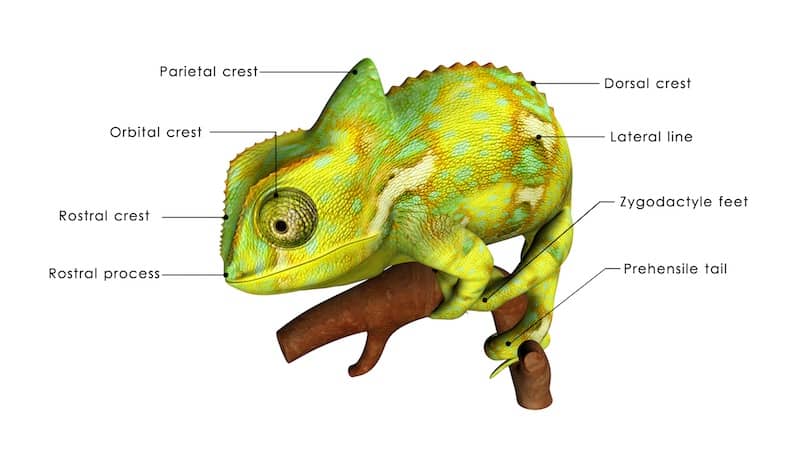Some chameleons will chow down on the plants in their tanks, especially hibiscus, ficus, and pothos. Other leafy greens they may enjoy include mustard greens, dandelion leaves, romaine lettuce, and kale. Additional vegetable choices include broccoli (both raw and cooked), alfalfa , zucchini, cooked carrots, yams, and cooked peas. A baby chameleon sometimes enjoys turnip greens. Chameleon noises are usually very quiet, but you might hear more from your pet as he is gnawing on a raw vegetable. Advertisement
advertisement
chameleons can also enjoy a variety of fruits and vegetables vicariously by a feeding method called "gut loading. " this means feeding your chameleon's prey with nutritious foods, such as any of the above fresh fruits and vegetables.

In captivity we have only a shadow of the diversity found in the wild. But it behooves us to take advantage of what we have. There are commercially available crickets, roaches, flies, beetle larva, hornworms, silkworms, and the list goes on. Reptile keeping has grown to the point where we have feeder businesses catering to us. Each continent and state will have their own blend of available insects. The key is to use as many as possible. Nutritious food is one of the important skills you will develop in chameleon keeping. You will develop skills in keeping different kinds of insects and feeding them to put them in top health and nutritional value. https://www.wikihow.com/Feed-a-Chameleon
Did this article help you?
Special substrates are not recommended for the veiled chameleon’s habitat. The chameleon will spend its days lounging in the plants and vines above the floor, so particle substrates are not needed. Plus, feeder insects may try to bury in them, making them more difficult for your chameleon to hunt and harder for you to clean. Some people choose to leave the floor uncovered, as this provides effortless cleanup. You can also select something simple like newspapers or paper towels. Just remember to change them at least once a week.
 https://www.chameleonforums.com/
https://www.chameleonforums.com/
Feeding your chameleon, no matter what age, doesn’t have to be complicated. When your chameleon is a baby, feed them between 12 and 18 insects throughout the day. As your chameleon grows , the number of insects and the frequency of feedings is reduced to five or six bugs every other day, but the size of the insect increases. After reading this article, we hope you have a better understanding of how much to feed your chameleon no matter what age. Load more.
Giving the Chameleon Food Using a Cup
Gut-loading in a nutshell is giving all your live-food a huge nutritional and hydration boost by feeding them the likes of quality greens, vegetables, fruits etc. Thus filling their digestive systems with goodness. And when fed to your chameleon that goodness is passed on to them. Go with the likes of spring greens, rocket, squash, lambs lettuce, herbs, fruits, fresh vegetables, the list is honestly endless. I put great care and thought into what i feed my bugs and i rotate food here also. You want good nutritional food items to be used, not just a piece of lettuce, which i have seen people do (this is not good).
There are three main feeding strategies. Hand feeding. This is where you perform some variation on you holding the feeder and the chameleon shoots it from your hand. You simply open the door, present the food and wait. If there is hesitation then try closing the door enough that you can put it between you and your chameleon so there appears to be barrier between the two of you. Chameleons learn that a closed cage means they are safe. This can help them feel safe around your hand. Controlled release. To produce a hunting response, feeder insects are released in the cage for the chameleon to hunt down.
Here is a list of foods that you’re best off avoiding: wild caught bugs: do not feed your chameleon anything you catch around your house. Wild caught bugs have a high chance of introducing parasites to your chameleon. Fireflies: very poisonous to chameleons… kale: can mess with your chameleon’s digestive system. Spinach: inhibits calcium absorbtion mango: toxic to chameleons broccoli: can mess with nutrient levels fruits are a tasty treat for your chameleon, but acidic fruits should be avoided altogether. Also, pay close attention to how consuming different insects affects your chameleon’s bowel movements. Quite a few chameleon owners report adverse effects when feeding their chameleons mealworms.
It’s imperative that any insect you feed your chameleon is gut loaded. Superworms eat vegetables and fruits, including sweet potato, carrot and apples, which are all excellent in nutrition and moisture. You can also feed them oats and wheat bran. You can also purchase commercial superworm food to add to their nutritional value. The commercial superworm food is a premium gut loading food for any feeder insect, providing optimal nutrition for your chameleon. It is designed with the correct ratios of calcium to phosphorus, along with vitamins d, a and e. Feed to feeder insects as much as they can eat 24 hour before you feed them to your chameleon pet.
